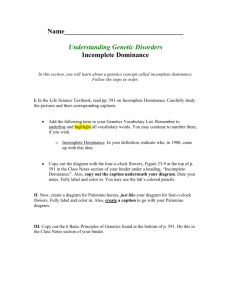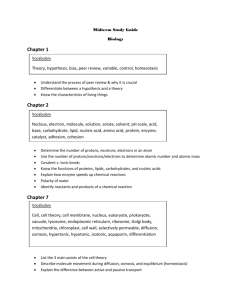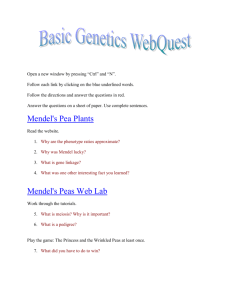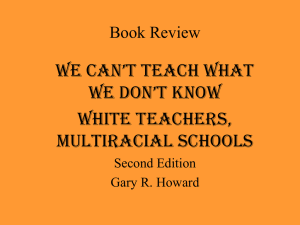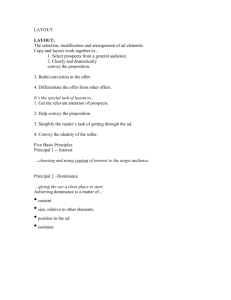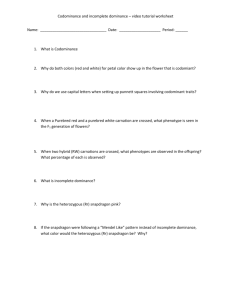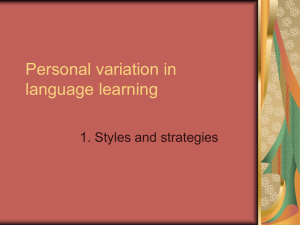Insecticide Resistance and Dominance Levels
advertisement
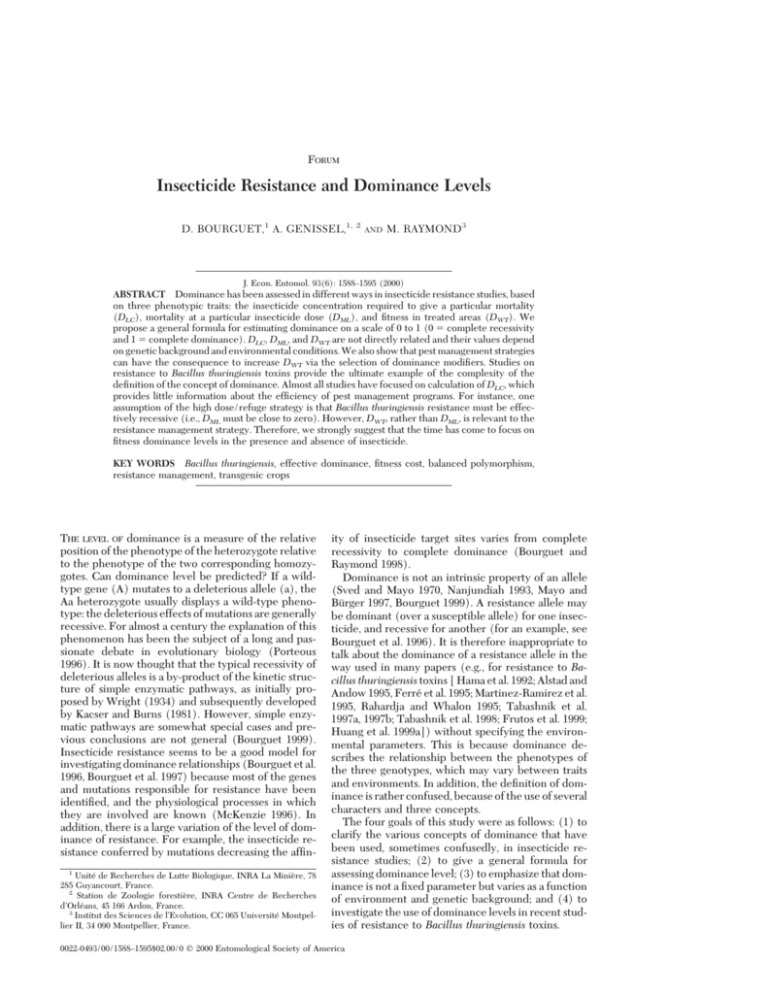
FORUM Insecticide Resistance and Dominance Levels D. BOURGUET,1 A. GENISSEL,1, 2 AND M. RAYMOND3 J. Econ. Entomol. 93(6): 1588Ð1595 (2000) ABSTRACT Dominance has been assessed in different ways in insecticide resistance studies, based on three phenotypic traits: the insecticide concentration required to give a particular mortality (DLC), mortality at a particular insecticide dose (DML), and Þtness in treated areas (DWT). We propose a general formula for estimating dominance on a scale of 0 to 1 (0 ⫽ complete recessivity and 1 ⫽ complete dominance). DLC, DML, and DWT are not directly related and their values depend on genetic background and environmental conditions. We also show that pest management strategies can have the consequence to increase DWT via the selection of dominance modiÞers. Studies on resistance to Bacillus thuringiensis toxins provide the ultimate example of the complexity of the deÞnition of the concept of dominance. Almost all studies have focused on calculation of DLC, which provides little information about the efÞciency of pest management programs. For instance, one assumption of the high dose/refuge strategy is that Bacillus thuringiensis resistance must be effectively recessive (i.e., DML must be close to zero). However, DWT, rather than DML, is relevant to the resistance management strategy. Therefore, we strongly suggest that the time has come to focus on Þtness dominance levels in the presence and absence of insecticide. KEY WORDS Bacillus thuringiensis, effective dominance, Þtness cost, balanced polymorphism, resistance management, transgenic crops THE LEVEL OF dominance is a measure of the relative position of the phenotype of the heterozygote relative to the phenotype of the two corresponding homozygotes. Can dominance level be predicted? If a wildtype gene (A) mutates to a deleterious allele (a), the Aa heterozygote usually displays a wild-type phenotype: the deleterious effects of mutations are generally recessive. For almost a century the explanation of this phenomenon has been the subject of a long and passionate debate in evolutionary biology (Porteous 1996). It is now thought that the typical recessivity of deleterious alleles is a by-product of the kinetic structure of simple enzymatic pathways, as initially proposed by Wright (1934) and subsequently developed by Kacser and Burns (1981). However, simple enzymatic pathways are somewhat special cases and previous conclusions are not general (Bourguet 1999). Insecticide resistance seems to be a good model for investigating dominance relationships (Bourguet et al. 1996, Bourguet et al. 1997) because most of the genes and mutations responsible for resistance have been identiÞed, and the physiological processes in which they are involved are known (McKenzie 1996). In addition, there is a large variation of the level of dominance of resistance. For example, the insecticide resistance conferred by mutations decreasing the afÞn1 Unité de Recherches de Lutte Biologique, INRA La Minière, 78 285 Guyancourt, France. 2 Station de Zoologie forestière, INRA Centre de Recherches dÕOrléans, 45 166 Ardon, France. 3 Institut des Sciences de lÕEvolution, CC 065 Université Montpellier II, 34 090 Montpellier, France. ity of insecticide target sites varies from complete recessivity to complete dominance (Bourguet and Raymond 1998). Dominance is not an intrinsic property of an allele (Sved and Mayo 1970, Nanjundiah 1993, Mayo and Bürger 1997, Bourguet 1999). A resistance allele may be dominant (over a susceptible allele) for one insecticide, and recessive for another (for an example, see Bourguet et al. 1996). It is therefore inappropriate to talk about the dominance of a resistance allele in the way used in many papers (e.g., for resistance to Bacillus thuringiensis toxins [ Hama et al. 1992; Alstad and Andow 1995, Ferré et al. 1995; Martinez-Ramirez et al. 1995, Rahardja and Whalon 1995; Tabashnik et al. 1997a, 1997b; Tabashnik et al. 1998; Frutos et al. 1999; Huang et al. 1999a]) without specifying the environmental parameters. This is because dominance describes the relationship between the phenotypes of the three genotypes, which may vary between traits and environments. In addition, the deÞnition of dominance is rather confused, because of the use of several characters and three concepts. The four goals of this study were as follows: (1) to clarify the various concepts of dominance that have been used, sometimes confusedly, in insecticide resistance studies; (2) to give a general formula for assessing dominance level; (3) to emphasize that dominance is not a Þxed parameter but varies as a function of environment and genetic background; and (4) to investigate the use of dominance levels in recent studies of resistance to Bacillus thuringiensis toxins. 0022-0493/00/1588Ð1595$02.00/0 䉷 2000 Entomological Society of America December 2000 BOURGUET ET AL.: INSECTICIDE RESISTANCE AND DOMINANCE LEVELS 1589 or dominant according to whether the hybrid mortality curve was closer to the susceptible or resistant mortality curve, respectively. Resistance was considered codominant (sometimes referred to as an absence of dominance) if hybrid mortality curves were equidistant from those of homozygotes. A quantitative measure of dominance level was then introduced by Stone (1968), using FalconerÕs formula (1964): D ⫽ 共2 logLCRS ⫺ logLCR ⫺ logLCS)/ (logLCR ⫺ logLCS), [1] where LCR, LCRS, and LCS are the lethal concentrations for the resistant, hybrid and susceptible individuals, respectively. D varies from ⫺1 to 1 (⫺1 ⫽ complete recessivity and 1 ⫽ complete dominance). D is usually calculated for a mortality level (ML) ⫽ 50% (Liu and Tabashnik 1997), set arbitrarily (Stone 1968), but may also be calculated as a function of ML, as shown by Bourguet et al. (1996, 1997). StoneÕs formula remains the most widely used method for determining the dominance of insecticide resistance. However, to obtain a more classical 0 Ð1 range, Bourguet et al. (1996, 1997), Bourguet and Raymond (1998) and Charlesworth (1998) have proposed the calculation of DLC as follows: Fig. 1. (A) Level of dominance of insecticide resistance. For each mortality level (ML), an insecticide concentration can be calculated for the susceptible (LCS) and resistant (LCR) strains and for heterozygotes (LCRS). The level of dominance of insecticide resistance is deÞned as DLC ⫽ (logLCRS ⫺ logLCS)/(logLCR ⫺ logLCS) and varies between 0 and 1. In the example, DLC ⫽ 0.7 at a ML of 50% (dotted line). (B) Dominance level of survival at a given insecticide dose (effective dominance). For any insecticide dose, an ML can be calculated for the three genotypes. Dominance level is calculated as DML ⫽ (MLRS ⫺ MLSS)/ (MLRR ⫺ MLSS). For the insecticide dose indicated by the arrow, DML ⫽ 0.6. Defining and Measuring Dominance Three different ways of assessing dominance level have been used in studies of insecticide resistance. First, dominance may be based on the position of the mortality curve for heterozygous individuals relative to those for both homozygotes, at a given mortality level (Fig. 1A). This is the dominance level of insecticide resistance. Second, the mortality of heterozygous individuals relative to that of both homozygotes, at a given insecticide concentration (Fig. 1B), has been used. This is the dominance level of survival at a given insecticide dose, often called effective dominance, closely related to dominance with respect to Þtness. The third way of assessing dominance compares the Þtness of the heterozygotes to that of the two homozygotes at a given insecticide dose. The Dominance of Insecticide Resistance. In toxicology, dominance level was initially determined by comparing the mortality curves of susceptible, resistant, and hybrid individuals (Milani 1963). Resistance was qualitatively (and arbitrarily) classed as recessive DLC ⫽ (logLCRS ⫺ logLCS)/(logLCR ⫺ logLCS). [2] Thus, following Liu and Tabashnik (1997). D LC ⫽ 共D ⫹ 1兲/ 2. [3] Effective Dominance. Curtis et al. (1978) were the Þrst to point out that DLC is of little value for pest resistance management. This is because strategies for delaying insecticide resistance mostly involve determining whether it is technically feasible to use doses such that all heterozygotes are killed (assuming monogenic resistance). Independently of the value of DLC, and depending on the doses applied “in practical conditions, either full dominance or full recessivity would effectively exist” (Curtis et al. 1978, p. 284). This led to the concept of effective dominance, which was further developed by Roush and McKenzie (1987). Hence, whereas DLC assesses the relative insecticide concentrations required to give a similar ML, effective dominance assesses the relative ML for a given insecticide concentration. We therefore refer to this dominance parameter as DML, which may be quantiÞed as follows: D ML ⫽ (MLRS ⫺ MLSS)/(MLRR ⫺ MLSS). [4] DML varies between 0 and 1 (0 ⫽ survival is recessive and 1 ⫽ survival is dominant). The Dominance of Relative Fitness in the Treated Area. We can deÞne the dominance of the advantage conferred by an insecticide resistance allele in the treated area (DWT) according to the following formula: D WT ⫽ (WTRS ⫺ WTSS)/(WTRR ⫺ WTSS), [5] where WTSS, WTRS, and WTRR are the relative Þtness in a treated area at a particular insecticide concen- 1590 JOURNAL OF ECONOMIC ENTOMOLOGY tration for susceptible homozygotes, heterozygotes, and resistant homozygotes, respectively. Values of DWT range from 0 to 1 (0 ⫽ recessive Þtness and 1 ⫽ dominant Þtness). As pointed out by a number of authors (e.g., Mallet and Porter 1992, Tabashnik 1994), DWT is related to h, the dominance level of Þtness or Þtness components deÞned in population genetics, with either DWT ⫽ h or DWT ⫽ 1- h, depending on whether homozygous resistant or susceptible individuals are used as the Þtness reference. Unfortunately, DWT has often been referred to as effective dominance (Mallet and Porter 1992) or as the genetic dominance coefÞcient (Mallet and Porter 1992, Tabashnik 1994), making unclear and confusing the distinction between the various dominance levels notably between DML and DWT. There is no obvious correlation between DWT and DML. Three cases must still be distinguished. The Þrst case is when insecticide concentrations give a MLRS ⱕ MLSS ⬍ 100%. In this situation, no predictions can be done. Although insecticide treatments certainly decrease the Þtness of the survivors we cannot predict how this Þtness will be modiÞed for each genotype. This can be illustrated with the following example where DML ⫽ 0.75: Mortality level (ML) Scenario 1 Relative Þtness of the survivor in the treated area Relative Þtness in the treated area (WT) Scenario 2 Relative Þtness of the survivor in the treated area Relative Þtness in the treated area (WT) Genotypes SS DML 80 0.75 20 0 0.5 1 1 0.1 0.8 1 0.5 0.75 1 0.1 0.6 1 DWT DWT RS RR 0.77 Vol. 93, no. 6 ment, the fertility and fecundity of females, and the survival of their offspring. If these components are more affected in RS than in RR individuals then DWT ⬍ DML. The last situation is when the insecticide concentration is lethal to all RS and SS individuals (MLRS ⫽ MLSS ⫽ 100%). In such a case DML and DWT are equivalent and equal to 0. A General Formula for Dominance Levels in Relation to Insecticide Resistance. As dominance depends on the character affected by the resistance gene, we can propose a general formula for calculating the dominance level for a phenotypic trait, X: D X ⫽ (XRS ⫺ XSS)/(XRR ⫺ XSS) [6] where XSS, XRS, and XRR are the quantitative values calculated for a trait X for susceptible homozygotes, heterozygotes, and resistant homozygotes, respectively. We have seen above that X may correspond to the log of the LC required to obtain a certain ML (for estimating DLC), the ML at a particular insecticide concentration (for estimating DML) or the relative Þtness in an insecticide-treated area (for estimating DWT). Hence a dominance level can be calculated for other traits, such as Þtness in an untreated area, or DWNT, corresponding to the dominance level of the Þtness cost: D WNT ⫽ (WNTRS ⫺ WNTSS)/(WNTRR ⫺ WNTSS) [7] where WNTSS, WNTRS, and WNTRR are relative Þtness in the absence of insecticide for susceptible homozygotes, heterozygotes, and resistant homozygotes, respectively. Similarly, a dominance level may be calculated for each Þtness component affected by the resistance allele in the absence or in presence of an insecticide. DX will always lie between 0 (trait recessive) and one (trait dominant). 0.55 In this example, RR and RS survivors may not differ in Þtness, whereas SS survivors have a relative Þtness of 0.5 (scenario 1). In this case, DWT ⫽ 0.77, which is a higher value than those calculated from the observed mortality level. However, if the relative Þtness of SS, RS, and RR that survive the insecticide treatment are 0.5, 0.75, and 1, respectively (scenario 2), then DWT ⫽ 0.55, which is less than DML. Interestingly, when DLC ⫽ 0 for all range of LC then DML ⫽ 0 whatever the mortality level induced by the insecticide concentration. As a consequence, when MLRS ⱕ MLSS ⬍ 100%, DWT does not necessarily equal DML if DML ⫽ 0. The second case correspond to the situation where MLRS ⬍ MLSS ⫽ 100%. In this situation we can predict DML to have a higher value than DWT. This is because heterozygous individuals that survive to the insecticide treatment may have a lower contribution to the gene pool than RR individuals. Unlike DWT, DML does not take into account all reductions in the Þtness components that may occur after survival of exposure to the insecticide. Other Þtness components that may be affected include mating success, larval develop- Variation, Plasticity, and Evolution of Dominance It is generally believed that the dominance level for a particular character (e.g., DLC, DML, DWT, DWNT) is a Þxed parameter. However, it may be inßuenced by environmental conditions and genetic background. Moreover, the selection of an insecticide resistance allele may be accompanied by an evolution of its dominance levels. In addition, selection may favor insecticide resistance alleles conferring more dominant phenotypes (e.g., Þtness) through allele replacement. Plasticity of Dominance. For a given insecticide DLC varies with certain environmental variables. This phenomenon is referred to as plasticity. Bourguet et al. (1996) studied the DLC of insecticide resistance conferred by an insensitive acetylcholinesterase in the mosquito Culex pipiens L. in two different environments, deÞned mainly by the water depth in the cup used for larval bioassays. DLC differed greatly between the two environments. For example, for ML ⫽ 50%, propoxur resistance varied from partial dominance (DLC ⫽ 0.7) to partial recessivity (DLC ⫽ 0.35), de- December 2000 BOURGUET ET AL.: INSECTICIDE RESISTANCE AND DOMINANCE LEVELS pending on water depth. For some of the insecticide concentrations considered, DML (and probably DWT) was also affected by such environmental differences. Dominance Modifiers. Changes in dominance may also arise because of alleles at linked or unlinked loci, which may be viewed as modiÞers of dominance. ModiÞers may be generalist, affecting the values of several dominance levels simultaneously, or more speciÞc, affecting the dominance level of one trait only. A dominance modiÞer has been reported for insecticide resistance by Grigolo and Oppenoorth (1966). They showed that in houseßies a DDT-ase, a detoxifying enzyme conferring a very low level of resistance level by itself, increased the DDT resistance conferred by sodium channel modiÞcation (kdr). The RS and RR mortality curves were modiÞed differently such that DLC was higher in the presence of the DTT-ase. Depending on the dose of DDT considered DML, and hence DWT, were also increased. The existence of dominance modiÞers for insecticide resistance is further suggested by data reported by Bourguet et al. (1997). They found that four resistant strains with a modiÞed acetylcholinesterase, originating from different geographical areas, differed in DLC. A correlation between greater acetylcholinesterase activity and higher DLC was found. Biochemical studies suggested that the strains did not differ in the amino acid sequence of the catalytically active regions of the acetylcholinesterase. Therefore, Bourguet et al. (1997) concluded that acetylcholinesterase synthesis was regulated by either neighboring or distant sites, thereby altering at least the DLC. Evolution of DWT and DWNT.The occurrence of modiÞers in natural populations raises the question as to whether selection for such modiÞers is possible. This is a key question because the selection of a resistance allele is favored by high values of DWT and low values of DWNT. According to the theoretical argument of Fisher (1931) and Sheppard (1958) and the analysis performed by Otto and Bourguet (1999), modiÞers increasing DWT and decreasing DWNT may be strongly selected if there is a balanced polymorphism, because heterozygotes are maintained at high frequencies for extended periods. Balanced polymorphism may be maintained either by overdominant selection or by migration in a patchy environment (Otto and Bourguet 1999). Overdominance occurs, rarely if at all, in insecticide resistance (but see Wool et al. 1982). Conversely, pest-managed areas are often heterogeneous environments with treated and untreated patches leading to the following Þtness matrix: Genotype RR RS SS Fitness in treated area (WT) Fitness in nontreated area (WNT) 1 1⫺c 1 ⫺ (1 ⫺ DWT)s 1 ⫺ DWNTc 1⫺s 1 where s and c are the selection coefÞcients in the presence and absence of insecticide, respectively. If a stable polymorphism is maintained, a modiÞer allele increasing the value of DWT or decreasing the value of DWNT is likely to invade the population (Otto and 1591 Bourguet 1999). Interestingly, even if the modiÞer increases heterozygote Þtness in one patch and decreases it in the second patch, the modiÞer can invade so long as it increases the weighted average Þtness over the two patches. In situations in which a balanced polymorphism is not maintained, modiÞers of DWT and DWNT may still be partly selected during the spread of insecticide resistance alleles throughout the population. However, such modiÞers are not necessarily present during this window of selection and, even if present, they may not increase in frequency before Þxation of the resistance allele (Haldane 1956). Finally, dominance may be modiÞed by the replacement of alleles conferring a recessive insecticide resistance by alleles conferring a more dominant resistance. Although cases of allele replacement have been described at insecticide resistance loci (e.g., Guillemaud et al. 1998, Lenormand et al. 1998), the extent to which dominance coefÞcients are affected is still unclear. Dominance of Bacillus thuringiensis Resistance Resistance to B. thuringiensis (Bt) toxins provides the ultimate example of confusion in the deÞnition of dominance level. Several genetic studies have been undertaken and more than half these studies did not quantify dominance (Table 1). Most studied only DLC, and none investigated DWT, which is the relevant dominance measure for predicting the evolution of Bt resistance. Dominance Levels of Bt Resistance. Bt resistance has often been deÞned as recessive according to mortality curves (Bourguet and Raymond 1998, Frutos et al. 1999). Here we report that DLC varies between 0.00 and 0.88 and that no general pattern emerged (see Table 1). Major cases of resistance to Bt correspond to modiÞcation of the toxin receptors. Bt toxins create channels that disrupt ion regulation, and the loss of afÞnity of the toxin for the receptor may account for Bt resistance being recessive if the formation of only a few pores is sufÞcient to cause osmotic swelling, cell lysis, and death, then in heterozygotes (with 50% sensitive receptors) the phenotype is likely to be the same as for susceptible homozygotes. For incompletely dominant resistance (0.5 ⬍ DLC ⬍ 1), it is possible that modiÞcation of midgut proteolytic activity rather than modiÞcation of the toxin receptor is responsible for resistance, as observed for a strain of O. nubilalis resistant to Dipel-ES (Huang et al. 1999b). Implications for Bt Resistance Management. The high dose/refuge strategy proposed by Georghiou and Taylor (1977) and developed by Alstad and Andow (1995) is the most appropriate for managing transgenic crops and is currently used for Bt cotton and Bt corn in North America (Ostlie et al. 1997). This strategy was developed for Bt crops partly because resistance to Bt toxins was initially found to be recessive, and could therefore be expected to be effectively recessive (Alstad and Andow 1995, Gould 1998, Roush 1998). Based on the considerations given above, the high dose/refuge strategy requires DML to be close to 0, a situation expected because DLC is sometimes low 1592 JOURNAL OF ECONOMIC ENTOMOLOGY Table 1. Vol. 93, no. 6 Review of the genetic studies on Bt resistance Species Toxins Data Dominance calculated by the author(s) Ñ Ñ Ñ Ñ Ñ Ñ Ñ Ñ 0.00 0.26 0.22 ⫺0.67 0.05 0.47 0.44 0.41 0.37 0.33 0.09 0.00 Ñ 0.63 Ñ 0.16 McGaughey (1985) McGaughey and Beeman (1988) McGaughey and Beeman (1988) McGaughey and Beeman (1988) McGaughey and Beeman (1988) McGaughey and Beeman (1988) Tabashnik et al. (1992) Martinez-Ramirez et al. (1995) Liu and Tabashnik (1997) Liu and Tabashnik (1997) Tabashnik et al. (1997a) Tang et al. (1997) Ñ D Ñ Ñ Ñ D Ñ ⫺0.73 Ñ Ñ Ñ 0.76 0.42 0.13 0.16 0.23 0.71 0.88 Imai and Mori (1999) Hama et al. (1992) Gould et al. (1995) Gould et al. (1992) Sims and Stone (1991) Rahardja and Whalon (1995) D D 0.72 ⫺0.58 0.86 0.21 Huang et al. (1999a) Chaufaux et al. (1997) Ñ Ñ Ñ Ñ Ñ Ñ Ñ Ñ h D h D LC LC LC LC LC LC LC LC ML LC ML LC No No No No No No No No Yes Yes Yes Yes Toarow CTe Toarow CT Cry1Ac, Cry1Ab Cry1Ac Not given Cry3A LC LC LC LC LC LC No Yes No No No Yes Ñ Ñ Ñ Ñ Ñ Ñ Ñ Ñ Hartl (1992)c Stone (1968)d Hartl (1992) Priesler et al. (1990)d Ñ Stone (1968) Ñ Ñ Ñ Stone (1968) Dipel Cry1C LC LC Yes Yes Stone (1968) Stone (1968) Leptinotarsa decemlineata Ostrinia nubilalis Spodoptera littoralis References Formula Plodia interpunctella Dipelb Dipel Dipel Dipel Dipel Dipel Plutella xylostella Dipel Cry1Ab Cry1C Cry1C Cry1Ac, Cry1Ab Javelinb Heliothis virescens DLCa Symbol Valuea QuantiÞcation For each study we review the type of data that were collected (lethal concentration [LC] or mortality level [ML]) and whether a dominance level was calculated. Those for which a dominance level had been quantiÞed we indicate the formula and the symbol used and the values that were obtained. Finally, for all studies which provided LC data, we give an estimation of the DLC. DLC was calculated as ⫽ (log LCRS ⫺ log LCS)/(log LCR ⫺ log LCS) using the LC50 of susceptible homozygous (LCs), resistant homozygous (LCR) and heterozygous individuals (LCRS). If not available LC50 was estimated directly from mortality curves. a If LC50 for both crosses (RR females ⫻ SS males) and (SS females ⫻ RR males) were available only the lowest dominance level is given unless the pooled F1 LC50 was available. Identically when several dominance levels were calculated for different toxins only the lowest dominance level is given. b Dipel and Javelin are commercial formulations of B. thuringiensis subsp. Kurstaki that contains spores and the genes for Cry1Aa, Cry1Ab, Cry1Ac, Cry2A and Cry2B. c HartlÕs (1992) formula corresponds to equation (5) for calculating DWT. d StoneÕs (1968) and PrieslerÕs et al. (1990) formulae correspond to equation (1) for calculating D. e Toarow CT䉸 is a commercial formulation containing 7.0% crystal toxin WP. The toxins contained in this formulation are not given. (see above). However, the actual DML depends not only on DLC but also on resistance ratio and the doses of toxin produced by transgenic Bt crops. Thus, even incomplete recessive Bt resistance (e.g., DLC ⬇0) can be effectively dominant (i.e., DML ⬎ 0.5) at some Bt concentrations. Heterozygote survival and DML may also be affected by the location on the Bt crop, the amount of resources available and the density of larvae feeding on the host plants. Moreover, such environmental variation may be associated with variations in toxin production over space and time in Bt plants. All these considerations were taking into account by the FIFRA ScientiÞc Panel to answer the questions posed by the U.S. Environmental Protection Agency on Bt plant-pesticide resistant management (EPA 1998a). Thus, in a meeting held in 1998, this ScientiÞc Panel deÞned the high dose as 25 times the concentration needed to kill susceptible larvae (EPA 1998b). Following our considerations this can be formalized by saying that EPA can expect DML ⫽ 0 when Bt crops produced 25 times the LC given a MLSS ⫽ 100%. However, the dominance measure relevant for predicting and managing Bt resistance is not effective dominance (DML), but the dominance level of Þtness, DWT. Therefore we must emphasize that the high dose/refuge strategy requires DWT, not DML, to be close to 0. When Bt crops kill all RS individuals, then DWT ⫽ DML ⫽ 0 so that measuring the dominance of the Þtness in transgenic Þelds is no longer required. One of the best examples is the work by Metz et al. (1995) showing that hybrids (putative heterozygotes) of the diamondback moth, Plutella xylostella (L.), do not survive on transgenic Bt broccoli. Similar results have been found for Heliothis virescens (F.) (Gould et al. 1997) and for Pectinophora gossipiela (Saunders) (Liu et al. 1999). Although such cases may be common, there is no certitude that all Bt plants in heterogeneous environments will work as well as they should do as underlined by the FIFRA ScientiÞc Panel (EPA 1998b). First, some Bt crops do not control all SS individuals. For example it is known that the Bt maize containing the transformation event #176 did not produce enough toxin to kill SS individuals during the second generation of infestation by the European corn borer, O. nubilalis (Hübner). Second, resistance to Bt crops may be a long story and we see no reason why Bt resistance alleles would never allow heterozygous individuals to survive on Bt crops. This has also been underlined by the FIFRA ScientiÞc Panel who recognized that it is conceivable that a heterozygote may develop with higher than 25-fold resistance (EPA 1998b). Thus, EPA is aware that DML would not systematically equal 0. December 2000 BOURGUET ET AL.: INSECTICIDE RESISTANCE AND DOMINANCE LEVELS When DML ⬎ 0, the actual DWT could not be directly predicted as demonstrated in a previous section. However, we have seen that when MLSS ⫽ 100%, DML certainly overestimates DWT. Thus, DWT can still equal 0 whenever DML ⬎ 0, which is good news for pest management in general and for the high dose refuge strategy in particular. Changes in the Dominance of Bt Resistance. The effect of the environment on the various measures of dominance for Bt resistance has not yet been investigated. Conversely, modiÞers of DLC and DML, and thus probably of DWT, have been identiÞed by Tabashnik et al. (1997b). It is therefore relevant to investigate whether the strategy implemented for managing Bt resistance may favor the selection of DWT modiÞers. The use of refuges to sustain the usefulness of transgenic Bt plants is leading to a fragmented landscape with two patch types. The Bt resistance allele is favored in a Bt patch, whereas it may confer a disadvantage in non-Bt patches, as suggested by Groeters et al. (1993, 1994). Therefore, a polymorphism at the resistance locus may be maintained by migration between transgenic and nontransgenic Bt plants, providing an ideal situation for the selection of modiÞers of dominance level (Otto and Bourguet 1999). The high dose/refuge strategy proposed by Alstad and Andow (1995) corresponds to a small-scale patch model with complete mixing among reproductive adults from each patch at each generation (Otto and Bourguet 1999). Assuming that offspring settle randomly within one of the two habitats, the chance of encountering a patch depends on its area. If the treated and untreated patches are assumed to account for a proportion ␣ and 1- ␣, respectively, of the total area, the Þtness averaged over the two patch types is as follows: WRR WRS WSS 1 ⫺ (1 ⫺ ␣)c 1 ⫺ (1 ⫺ DWT)␣s ⫺ 1 (1 ⫺ ␣)DWNTc 1 ⫺ ␣s A balanced polymorphism will be maintained if WRS ⬎ WSS and WRR (Otto and Bourguet 1999). Concerning the high dose/refuge strategy, it is often recommended that s, DWT, and ␣ are initially equal to 1, 0, and 0.8, respectively (Roush 1997). If these conditions are met, then the condition WRS ⬎ WSS and WRR is never satisÞed. Thus, this strategy cannot lead to a globally stable polymorphism and does not allow extensive modiÞcation of DWT or DWNT to occur. ModiÞers of the dominance measures DWT and DWNT may still be partly selected during the spread of Bt resistance alleles through the population. Dominance may also be modiÞed by the replacement of alleles conferring a recessive Bt resistance by alleles conferring a more dominant resistance. In conclusion, three dominance measures related to resistance have been used in insecticide resistance studies. These dominance measures reßect three different phenotypic traits: the insecticide concentration required to give a particular ML, the ML at a particular insecticide dose, and the Þtness in treated areas. To 1593 distinguish clearly among these dominance measures we refer to them as DLC, DML, and DWT, respectively. All these dominance measures can be estimated by the same general formula given above. Other dominance measures related to an insecticide resistance allele, such as the dominance of Þtness in untreated areas (DWNT) can also be calculated with this simple formula. All these dominance measures vary between 0 (complete recessivity) to 1 (complete dominance). Both DLC and DML can be directly inferred from mortality curves and may be plotted as a function of toxin concentration and ML, respectively. Nevertheless, DML depends on three parameters: the resistance ratio, the dominance of resistance DLC, and the dose of toxin. Models predicting changes in allele frequency compare the relative Þtnesses of the three genotypes SS, RS, and RR. DWT and DWNT, the dominance levels of Þtness in the presence and absence of insecticide, respectively, are therefore required for such models. It has been claimed that s ⫽ LCRR Ð LCSS (Arpaia et al. 1998). We see no reason why s should be considered to be the difference between the LC of the two homozygotes. Actually, s depends on the insecticide concentration in the treated patch, which may vary spatially within the patch, so the coefÞcient of selection cannot be directly related to the position of the heterozygote mortality curve relative to those of the homozygote curves. More generally, none of the dominance measures described in this article (DLC, DML, DWT, DWNT) are directly related to any of the others. DWT is a key parameter with a large impact on the implementation of resistance management strategies (Lenormand and Raymond 1998). Estimating DWT in natural populations is difÞcult because insecticide concentration in the treated area (and the toxin concentration in transgenic Bt crops) and s are variable in time and space. In addition, DWT may be affected by genetic background and environmental factors, as suggested by the variation of DLC (Bourguet et al. 1996, 1997), and may change during selection of the insecticide resistance allele. No study of the genetics of insecticide resistance has yet focused on calculation of the dominance measure DWT. We strongly suggest that the time has come to focus on the estimation of DWT and DWNT. We are aware that such estimations will be a difÞcult task notably in natural populations. However, some researchers have already measured components of the Þtness in the Þeld with and without insecticide applications (McKenzie and Whitten 1984, Follet et al. 1993 and Chevillon et al. 1998). When resistance is rare (notably and currently for Bt resistance), release of heterozygotes and resistant homozygotes would be unethical so that such estimation must only be done in the laboratory or in controlled Þeld experiments. Acknowledgments We thank two anonymous reviewers for helpful comments and notably for clarifying the relation between DWT and DML. This work was supported by the INRA AIP “Organismes 1594 JOURNAL OF ECONOMIC ENTOMOLOGY Génétiquement Modifés et Environnement” and by the MENRT A.O. “Impact des OGM.” This is publication ISEM No. 00-076. References Cited Alstad, D., and D. A. Andow. 1995. Managing the evolution of insect resistance to transgenic plants. Science 268: 1894 Ð1896. Arpaia, S., K. Chiriatti, and G. Giorio. 1998. Predicting the adaptation of Colorado potato beetle (Coleoptera: Chrysomelidae) to transgenic eggplants expressing CryIII toxin: the role of gene dominance, migration, and Þtness costs. J. Econ. Entomol. 91: 21Ð29. Bourguet, D. 1999. The evolution of dominance. Heredity 83: 1Ð 4. Bourguet, D., T. Lenormand, T. Guillemaud, V. Marcel, D. Fournier and M. Raymond. 1997. Variation of dominance of newly arisen adaptive genes. Genetics 147: 1225Ð 1234. Bourguet, D., M. Prout, and M. Raymond. 1996. Dominance of insecticide resistance presents a plastic response. Genetics 143: 407Ð 416. Bourguet, D., and M. Raymond. 1998. The molecular basis of dominance relationships: the case of some recent adaptive genes. J. Evol. Biol. 11: 103Ð122. Charlesworth, B. 1998. Adaptive evolution: the struggle for dominance. Curr. Biol. 8: R502ÐR504. Chaufaux, J., J. Müller-Cohn, C. Buisson, V. Sanchis, D. Lereclus, and N. Pasteur. 1997. Inheritance of resistance to the Bacillus thuringiensis CryIC toxin in Spodoptera littoralis (Lepidoptera: Noctuidae). J. Econ. Entomol. 90: 873Ð 878. Chevillon, C., D. Bourguet, F. Rousset, N. Pasteur, and M. Raymond. 1998. Pleiotropy of adaptive changes in populations: comparisons among insecticide resistance genes in Culex pipiens. Genet. Res. 70: 195Ð204. Curtis, C. F., L. M. Cook, and R. J. Wood. 1978. Selection for and against insecticide resistance and possible methods of inhibiting the evolution of resistance in mosquitoes. Ecol. Entomol. 3: 273Ð287. [EPA]Environmental Protection Agency. 1998a. The Environmental AgencyÕs White Paper on Bt Plant-Resistance Management. 14 January 1998. US EPA, Washington, DC. [EPA]Environmental Protection Agency. 1998b. Final Report of the FIFRA ScientiÞc Advisory Panel Subpanel on Bacillus thuringiensis (Bt) Plant and Resistance Management, Meeting held on 9 Ð10 February. US EPA, Washington, DC. Falconer, D. S. 1964. Introduction to quantitative genetics. Oliver and Boyd, Edinburgh. Ferré, J., B. Escriche, Y. Bel, and J. Van Rie. 1995. Biochemistry and genetics of insect resistance to Bacillus thuringiensis insecticidal crystal proteins. FEMS Microbiol. Lett. 132: 1Ð7. Fisher, R. A. 1931. The evolution of dominance. Biol. Rev. 6: 345Ð368. Follett, P.A., F. Gould, and G. G. Kennedy. 1993. Comparative Þtness of three strains of Colorado potato beetle (Coleoptera: Chrysomelidae) in the Þeld: spatial and temporal variation in insecticide selection. J. Econ. Entomol. 86: 1324 Ð1333. Frutos, R., C. Rang, and F. Royer. 1999. Managing insect resistance to plants producing Bacillus thuringiensis toxins. Crit. Rev. Biotech. 19: 227Ð276. Vol. 93, no. 6 Georghiou, G. P., and C. E. Taylor. 1977. Operational inßuences in the evolution of insecticide resistance. J. Econ. Entomol. 70: 653Ð 658. Gould, F. 1998. Sustainability of transgenic insecticidal cultivars: integrating pest genetics and ecology. Annu. Rev. Entomol. 43: 701Ð726. Gould, F., A. Martinez-Ramirez, A. Anderson, J. Ferré, F. J. Silva, and W. J. Moar. 1992. Broad-spectrum resistance to Bacillus thuringiensis toxins in Heliothis virescens. Proc. Natl. Acad. Sci. USA 89: 7986 Ð7990. Gould, F., A. Anderson, A. Reynolds, L. Bumgarner, and W. Moar. 1995. Selection and genetic analysis of a Heliothis virescens (Lepidoptera: Noctuidae) strain with high levels of resistance to Bacillus thuringiensis toxins. J. Econ. Entomol. 88: 1545Ð1559. Gould, F., A. Anderson, A. Jones, D. Sumerford, D. Heckel, J. Lopez, S. Micinski, R. Leonard, and M. Laster. 1997. Initial frequency of alleles for resistance to Bacillus thuringiensis toxins in Þeld populations of Heliothis virescens. Proc. Natl. Acad. Sci. U.S.A. 94: 3519 Ð3523. Grigolo, A., and F. J. Oppenoorth. 1966. The importance of DDT-Dehydrochlorinase for the effect of the resistance gene kdr in the houseßy Musca domestica L. Genetica 37: 159 Ð170. Groeters, F. R., B. E. Tabashnik, N. Finson, and M. W. Johnson. 1993. Resistance to Bacillus thuringiensis affects mating success of the diamondback moth (Lepidoptera: Plutellidae). J. Econ. Entomol. 86: 1035Ð1039. Groeters, F. R., B. E. Tabashnik, N. Finson, and M. Johnson. 1994. Fitness costs of resistance to Bacillus thuringiensis in the diamondback moth (Plutella Xylostella). Evolution 48: 197Ð201. Guillemaud, T., T. Lenormand, D. Bourguet, C. Chevillon, N. Pasteur, and M. Raymond. 1998. Evolution of resistance in Culex pipiens: allele replacement and changing environment. Evolution 52: 443Ð 453. Haldane, J.B.S. 1956. The theory of selection for melanism in Lepidoptera. Proc. R. Soc. Lond. B 145: 303Ð306. Hama, H., K. Suzuki, and H. Tanaka. 1992. Inheritance and stability of resistance to Bacillus thuringiensis formulations of the diamondback moth, Plutella xylostella (Linnaeus) Lepidoptera: Yponomeutidae). Appl. Entomol. Zool. 27: 355Ð362. Hartl, D. L. 1992. A primer of population genetics, 2nd ed. Sinauer, Sunderland, MA. Huang, F., L. L. Buschman, R. A. Higgins, and W. H. McGaughey. 1999a. Inheritance of resistance to Bacillus thuringiensis toxin (Dipel ES) in the European corn borer. Science 284: 965Ð967. Huang, F. N., K. Y. Zhu, L. L. Buschman, R. A. Higgins, and B. Oppert. 1999b. Comparison of midgut proteinases in Bacillus thuringiensis-susceptible and -resistant European corn borer, Ostrinia nubilalis (Lepidoptera:Pyralidae). Pest. Biochem. Physiol. 65: 132Ð139. Imai, K., and Y. Mori. 1999. Levels, inheritance and stability of resistance to Bacillus thuringiensis formulation in a Þeld population of the diamondback moth, Plutella xylostella (Lepidoptera: Plutellidae) from Thailand. Appl. Entomol. Zool. 34: 23Ð29. Kacser, H., and J. A. Burns. 1981. The molecular basis of dominance. Genetics 97: 639 Ð 666. Lenormand, T., T. Guillemaud, D. Bourguet, and M. Raymond. 1998. Appearance and sweep of a gene duplication: adaptive response and potential for new functions in the mosquito Culex pipiens. Evolution 52: 1705Ð1712. Lenormand, T., and M. Raymond. 1998. Resistance management: the stable zone strategy. Proc. R. Soc. Lond. B 265: 1985Ð1990. December 2000 BOURGUET ET AL.: INSECTICIDE RESISTANCE AND DOMINANCE LEVELS Liu, Y.-B., and B. E. Tabashnik. 1997. Inheritance of resistance to the Bacillus thuringiensis toxin Cry1C in the diamondback moth. Appl. Environ. Microbiol. 63: 2218 Ð 2223. Liu, Y.-B., B. E. Tabashnik, T. J. Dennehy, A. L. Patin, and A. C. Bartlett. 1999. Development time and resistance to Bt crops. Nature (Lond.) 400: 519. Mallet, J., and P. Porter. 1992. Preventing insect adaptation to insect-resistant crops: are seed mixtures or refugia the best strategy? Proc. R. Soc. Lond. B 250: 165Ð169. Martinez-Ramirez, A. C., B. Escriche, M. Dolores Real, J. Silva, and J. Ferré. 1995. Inheritance of resistance to a Bacillus thuringiensis toxin in a Þeld population of diamondback moth (Plutella xylostella). Pestic. Sci. 43: 115Ð 120. Mayo, O., and R. Bürger. 1997. The evolution of dominance: a theory whose time has passed? Biol. Rev 72: 97Ð110. McGaughey, W. H. 1985. Insect resistance to the biological insecticide Bacillus thuringiensis. Science 229: 193Ð195. McGaughey, W. H., and R. W. Beeman. 1988. Resistance to Bacillus thuringiensis in colonies of indianmeal moth and almond moth (Lepidoptera: Pyralidae). J. Econ. Entomol. 81: 28 Ð33. McKenzie, J. A., and M. J. Whitten. 1984. Estimation of relative viabilities of insecticide resistance genotypes of the Australian sheep blowßy, Lucilia cuprina. Aust. J. Biol. Sci. 37: 45Ð52. McKenzie, J. A. 1996. Ecological and evolutionary aspects of insecticide resistance. Academic, San Diego, CA. Metz, T. D., R. T. Roush, J. D. Tang, A. M. Shelton, and E. D. Earle. 1995. Transgenic broccoli expressing a Bacillus thuringiensis insecticidal crystal protein: implications for pest resistance management strategies. Mol. Breed. 1: 309 Ð317. Milani, R. 1963. Genetical aspects of insecticide resistance. Bull. W.H.O. 29: 77Ð 87. Nanjundiah, V. 1993. Why are most mutations recessive? J. Genet. 72: 85Ð97. Ostlie, K. R., W. D. Hutchinson, and R. L. Hellmich [eds.]. 1997. Bt corn and European corn borer. NCR publication 602. Univeristy of Minnesota, St. Paul, MN. Otto, S. P., and D. Bourguet. 1999. Balanced polymorphisms and the evolution of dominance. Am. Nat. 153: 561Ð574. Porteous, J. W. 1996. Dominance-one hundred and Þfteen years after MendelÕs paper. J. Theor. Biol. 182: 223Ð232. Priesler, H. K., M. A. Hoy, and J. L. Robertson. 1990. Statistical analysis of modes of inheritance for pesticide resistance. J. Econ. Entomol. 83: 1649 Ð1655. Rahardja, U., and M. E. Whalon. 1995. Inheritance of resistance to Bacillus thuringiensis subsp. tenebrionis CryIIIA delta-endotoxin in Colorado potato beetle (Coleoptera: Chrysomelidae). J. Econ. Entomol. 88: 21Ð26. Roush, R. T. 1997. Bt-transgenic crops: just another pretty insecticide or a chance for a new start in resistance management? Pestic. Sci 51: 328 Ð334. Roush, R. T. 1998. Two-toxin strategies for management of insecticidal transgenic crops: can pyramiding succeed 1595 where pesticide mixtures have not? Philos. Trans. R. Soc. Lond. B 353: 1777Ð1786. Roush, R. T., and J. A. McKenzie. 1987. Ecological genetics of insecticide and acaricide resistance. Annu. Rev. Entomol. 32: 361Ð380. Sheppard, P. M. 1958. The evolution of dominance, pp. 129145. In Natural selection and heredity. 1st ed. Hutchinson, London. Sims, S. R., and T. B. Stone. 1991. Genetic basis of Tobacco budworm resistance to an engineered Pseudomonas fluorescens expressing the ␦-Endotoxin of Bacillus thuringiensis kurstaki. J. Invertebr. Pathol. 57: 206 Ð210. Stone, B. F. 1968. A formula for determining degree of dominance in cases of monofactorial inheritance of resistance to chemicals. Bull. W.H.O. 38: 325Ð328. Sved, J. A., and O. Mayo. 1970. The evolution of dominance, pp. 289 Ð316. In K.-I. Kojima [ed.], Mathematical topics in population genetics. Springer, Berlin. Tabashnik, B. T. 1994. Delaying insect adaptation to transgenic plants: seed mixture and refugia reconsidered. Proc. R. Soc. Lond. B 255: 7Ð12. Tabashnik, B. E., J. M. Schwartz, N. Finson, and M. W. Johnson. 1992. Inheritance of resistance to Bacillus thuringiensis in diamondback moth (Lepidoptera: Plutellidae). J. Econ. Entomol. 85: 1046 Ð1055. Tabashnik, B. E., Y. B. Liu, T. Malvar, D. G. Heckel, L. Masson, V. Ballester, F. Granero, J. L. Mensua, and J. Ferré. 1997a. Global variation in the genetic and biochemical basis of diamondback moth resistance to Bacillus thuringiensis. Proc. Natl. Acad. Sci. U.S.A. 94: 12780 Ð 12785. Tabashnik, B. E., Y.-B. Liu, N. Finson, L. Masson, and D. Heckel. 1997b. One gene in diamondback moth confers resistance to four Bacillus thuringiensis toxins. Proc. Natl. Acad. Sci. U.S.A. 94: 1640 Ð1644. Tabashnik, B. E., Y. B. Liu, T. Malvar, D. G. Heckel, L. Masson, and J. Ferré. 1998. Insect resistance to Bacillus thuringiensis: uniform or diverse? Philos. Trans. R. Soc. Lond. B 353: 1751Ð1756. Tang, J. D., S. Gilboa, R. T. Roush, and A. M. Shelton. 1997. Inheritance, stability, and lack-of-Þtness costs of Þeldselected resistance to Bacillus thuringiensis in diamondback moth (Lepidoptera: plutellidae) from Florida. J. Econ. Entomol. 90: 732Ð741. Wool, D., S. Noiman, O. Manheim, and E. Cohen. 1982. Malathion resistance in Tribolium strains and their hybrids: inheritance patterns and possible enzymatic mechanisms (Coleoptera, Tenebrionidae). Biochem. Genet. 20: 621Ð 636. Wright, S. 1934. Physiological and evolutionary theories of dominance. Am. Nat. 67: 24 Ð53. Received for publication 22 March 2000; accepted 20 July 2000.

